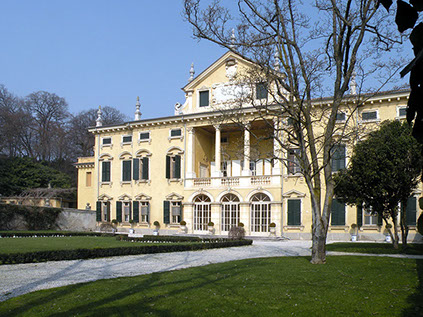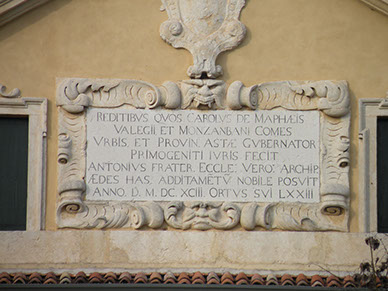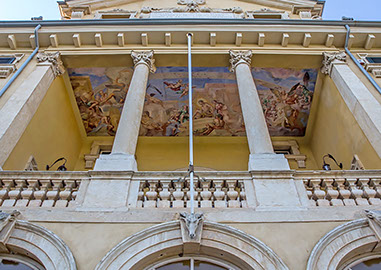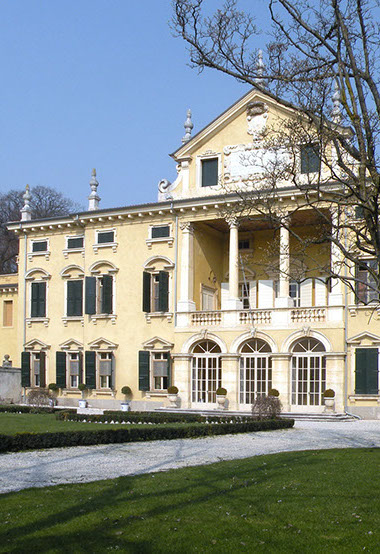Progetto di valorizzazione
del territorio di Valeggio sul Mincio
Villa Maffei Nuvoloni
Sigurtà
XVII SECOLO
Il 21 luglio 1649, il Doge di Venezia Francesco Molin insediava ufficialmente i fratelli Alvise e Carlo Maffei, patrizi veronesi, nei feudi di Valeggio e Monzambano, elevandoli alla dignità di conti, con possibilità di trasmettere possedimenti, giurisdizioni e onori ai loro discendenti maschi in perpetuo.
Gli investimenti economici della famiglia veronese dei Maffei, nel Vicariato di Valeggio, iniziarono sul finire del XV secolo e furono indirizzati prevalentemente all’acquisto di nuovi terreni agricoli e alla costruzione di mulini lungo il corso del Mincio.
L’investitura dogale sancì l’apice del potere economico e politico dei Maffei e la testimonianza tangibile del loro successo fu la costruzione, negli anni novanta del Seicento, di questa splendida Villa veneta.
La progettazione della sontuosa dimora si deve a Vincenzo Pellesina (1637-1700).
Memore della grande lezione palladiana, l’architetto veronese compì l’opera nel pieno della maturità, sottolineando il trapasso stilistico dal barocco al neoclassico.
Nel timpano che caratterizza l’elegante facciata, una lapide ricorda l’Arciprete don Antonio Maffei che, grazie a quanto lasciatogli dal fratello Carlo, completò l’edificazione della dimora nell’anno 1693, all’età di 73 anni.
La bellezza della Villa, armoniosa di forme, risalta nell’alta loggia affrescata da Biagio Falcieri (1628-1703), spartita fra due colonne e due paraste.
Nelle tre porte di ingresso le chiavi di volta mostrano teste di cervo emblema araldico dei Maffei.
Alcuni saloni interni e lo scalone d’onore sono affrescati. Il giardino anteriore è chiuso da mura e da cancelli in ferro battuto.
Negli anni quaranta del Novecento, la proprietà fu acquistata dall’industriale farmaceutico mantovano, dott. Carlo Giuseppe Sigurtà (1898-1983); il quale, in tanti anni di lavoro appassionato, ha trasformato l’antico Brolo retrostante la Villa, da lui denominata “Villa alla Quercia”, in una meraviglia botanica nota in tutto il mondo e aperta al pubblico dal 1978.
La Villa in ogni tempo ha ospitato personaggi storici e personalità del mondo politico, culturale e scientifico internazionale.
Ora è sede di eventi culturali, musicali e di intrattenimenti privati e pubblici.
Villa "Maffei Nuvoloni
Sigurtà"
17th CENTURY
On July 21th, 1649, the Doge of Venice, Francesco Molin, officially handed over the fiefdom of Valeggio and Monzambano to the Alvise and Carlo Maffei, patricians of Verona, elevating them to the dignity of Earls, with the possibility of transmitting, jurisdictions and honors to their male descendants perpetual.
The economic investments of the Veronese family of the Maffei, in the Vicariate of Valeggio, began at the end of the 15th century and were mainly directed towards the purchase of new agricultural land and the construction of mills along the course of the Mincio.
The dogal investiture sanctioned the apex of the economic and political power of the Maffei and the tangible testimony of their success was the construction, in the nineties of the 17th century, of this splendid Venetian Villa on older factories.
The design of the sumptuous residence is due to Vincenzo Pellesina (1637-1700).
Mindful of the great Palladian lesson, the Veronese architect carried out the work in full maturity, emphasizing the stylistic transition from the baroque to the neoclassical.
In the tympanum, that characterizes the elegant façade, a plaque commemorates the Archpriest Don Antonio Maffei who, thanks to what was left by his brother Carlo, completed the construction of the dwelling in 1693, at the age of 73 years.
The beauty of the Villa, harmonious in form, stands out in the high loggia frescoed by Biagio Falcieri (1628-1703), divided between two columns and two pilasters.
In the three entrance doors with round arches, the keystones show deer heads, the Maffei heraldic emblem. Some internal halls and the staircase are frescoed.
The front garden is enclosed by walls and wrought iron gates. In the forties of the twentieth century, the property was purchased by the pharmaceutical industrialist Dr. Carlo Giuseppe Sigurtà (1898-1983); who, over many years of passionate work, has transformed the ancient Brolo (Park) behind the Villa, which he named "Villa alla Quercia" (Oak Villa), into a botanical wonder known throughout the world and open to the public since 1978.
The Villa at all times has hosted high level personalities from the political, military, cultural, economic and international scientific world.
Now it is home to cultural, musical, private and public entertainment events.
Villa Maffei Nuvoloni Sigurtà
17. Jhr.
Architektonische Route
Am 21. Juli 1649 ernannte Francesco Molin, Doge von Venedig, offiziell die Veroneser Patrizier Alvise und Carlo Maffei zu den Lehnherren von Valeggio und Monzambano und erhob sie in den Stand der Grafen, die das Recht hatten, an ihre männlichen Nachfahren Güter, Gerichtsbarkeit und Ehren zu vererben.
Die wirtschaftlichen Investitionen der Veroneser Familie Maffei im Vikariat von Valeggio begannen am Ende des 15. Jahrhunderts und wurden vorwiegend für den Kauf von neuen landwirtschaftlichen Gründen und den Bau von Mühlen entlang des Mincios benutzt. Die Die Investitur des Dogen bezeichnete den Höhepunkt der wirtschaftlichen und politischen Macht der Maffei.
Das sichtbare Zeugnis für ihren Erfolg war der Bau dieser wunderschönen Venetischen Villa in den 90iger Jahren des 17. Jahrhunderts. Der Entwurf des prunkvollen Gebäudes stammt von Vincenzo Pellesina (1637-1700). Der Veroneser Architekt war ein Schüler der großen Palladianischen Schule, der das Werk in seinen reifen Jahren verwirklichte und den stilistischen Übergang vom Barock auf die Neuklassik betonte.
Im Tympanon der eleganten Fassade erinnert eine Tafel an den Erzpriester Don Antonio Maffei, der dank des Erbes seines Bruders Carlo im Alter von 73 Jahren den Bau des Gebäudes im Jahr 1693 fertigstellte. Die Schönheit der Villa mit ihren harmonischen Formen wird in der hohen Loggia mit Fresken von Biagio Falcieri (1628-1703) betont, die von zwei Säulen und Wandpfeilern getrennt ist.
In den drei Eingangstoren enthalten die Gewölbeschlüssel Hirschköpfe, die das araldische Emblem der Maffei sind. Einige Innensalons und die Prunktreppe sind mit Fresken verziert. Der Vordergarten ist von einer Mauer und Gattern aus Gusseisen umgeben.
In den 40iger Jahren des 20. Jahrhunderts wurde das Gebäude von Dott. Carlo Giuseppe Sigurtà (1898-1983), dem Besitzer eines Pharmabetriebs aus Mantua erworben, der in vielen Jahren leidenschaftlicher Arbeit den ehemaligen Brolo hinter der Villa, die er „Villa alla Quercia“ (Villa an der Eiche) nannte, in einen traumhaften Garten verwandelte, der in aller Welt bekannt ist und seit 1978 der Öffentlichkeit zugänglich ist.
In der Villa verweilten historische Persönlichkeiten und wichtige internationale Personen aus Politik, Kultur und Wissenschaft. Heute finden im Gebäude kulturelle, musikalische, private und öffentliche Veranstaltungen statt.




la loggia

la camera di Napoleone
© 2019
Comune di Valeggio sul Mincio (VR)
Associazione Percorsi


